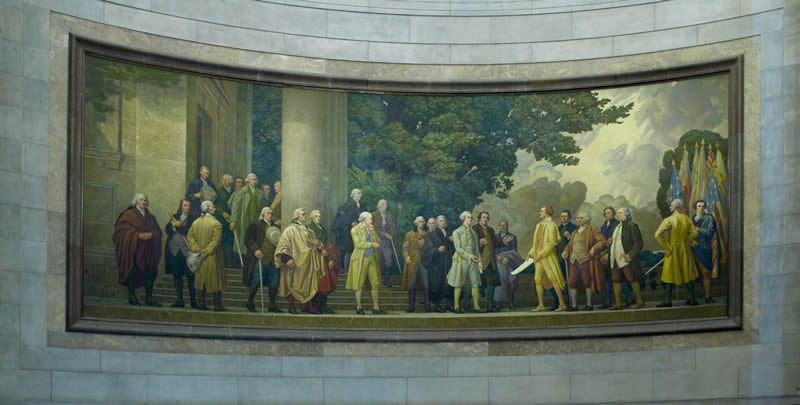Declaration Mural
 Declaration Mural photo by Carol Highsmith
Declaration Mural photo by Carol HighsmithWhen the National Archives Building was built in the mid-1930s, the architects designed and built an exhibition hall that included space for two large murals, measuring 14 by 36 feet, celebrating the nation's founding documents. The muralist commissioned for the project, Barry Faulkner, decided paint to large murals, one depicting the signing of the Declaration of Independence and the other showing the adoption of the Constitution.
Both murals are Faulkner’s own imagined interpretation of events, not historically accurate depictions. In reality, the people shown were never in the room at the same time for any dramatic presentation of the documents that forged a nation.
Working from portraits and woodcuts of the Founders as well as historical descriptions about their height, coloring, and wardrobe, Faulkner costumed and posed live models, and then he and his assistants spent a year making small sketches of each person, then a small-scale color rendering of the murals, before beginning to paint the huge canvasses.
Rather than placing the delegates in Independence Hall in Philadelphia where the conventions were held, Faulkner designed a landscape background using the skies to increase the drama of the murals. The sky in the Declaration mural is dark and stormy, symbolizing its adoption in the midst of war, and the flags seen in the background are well-known Revolutionary battle flags.
Did you know?
Each mural weighs approximately 350 pounds and measures 14 ft by 35 ft. They are among the largest single-piece oil-on-canvas murals in the United States.Faulkner’s studio wasn’t large enough to accommodate the massive canvases so he moved his studio to the cavernous attic of Grand Central Station New York to complete the murals.
Faulkner wanted to tie in the contribution of Abraham Lincoln and the Emancipation Proclamation with the signing of the Declaration of Independence, so he painted Lincoln’s profile into one of the clouds.
Additional Resources:
- The National Archives Building: Temple of American History by Patty Reinert Mason.
- “Restoring the Historic Murals in the National Archives Building” by Richard Blondo, Archives Specialist, National Archives Building Renovation Team

